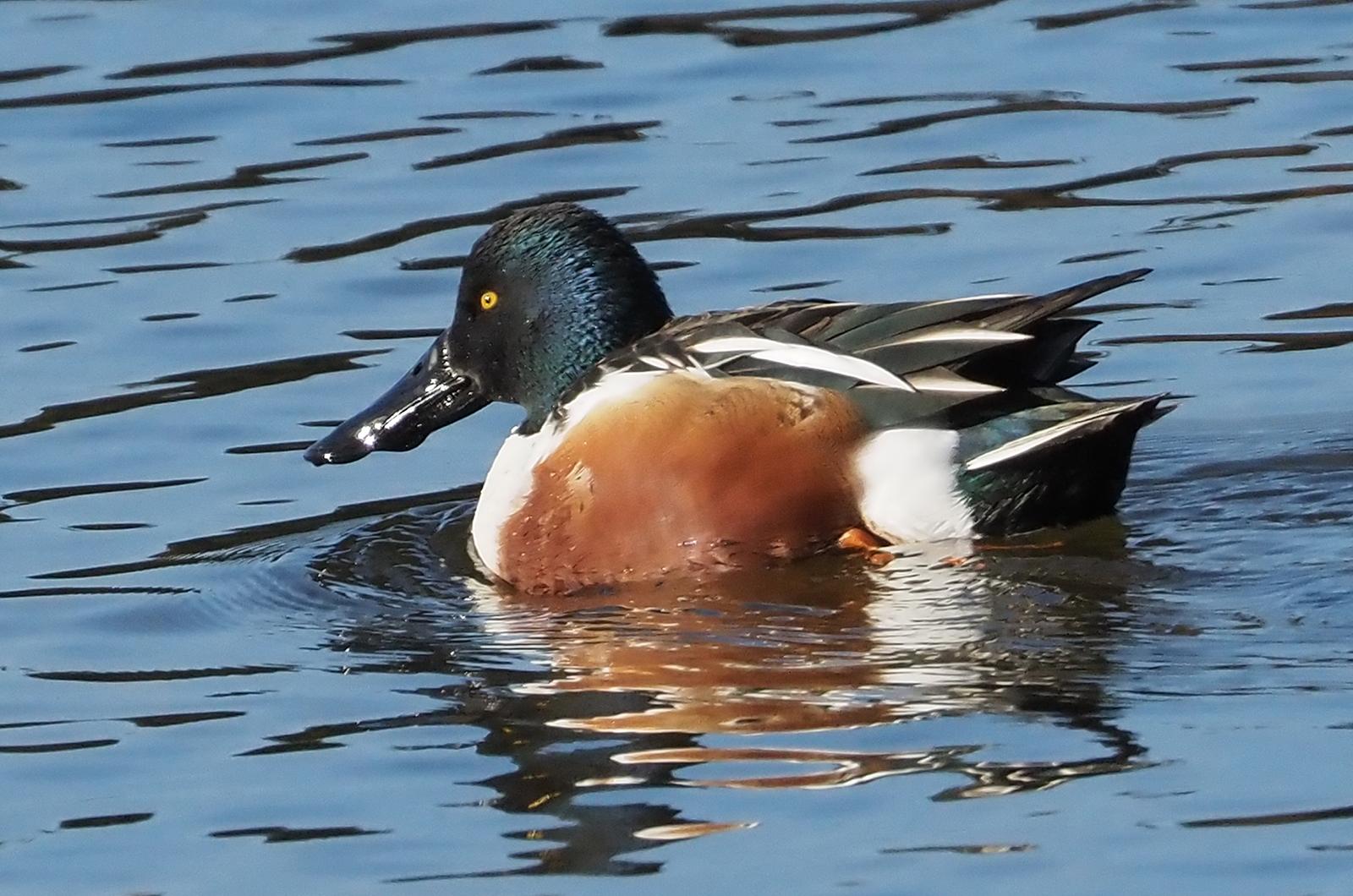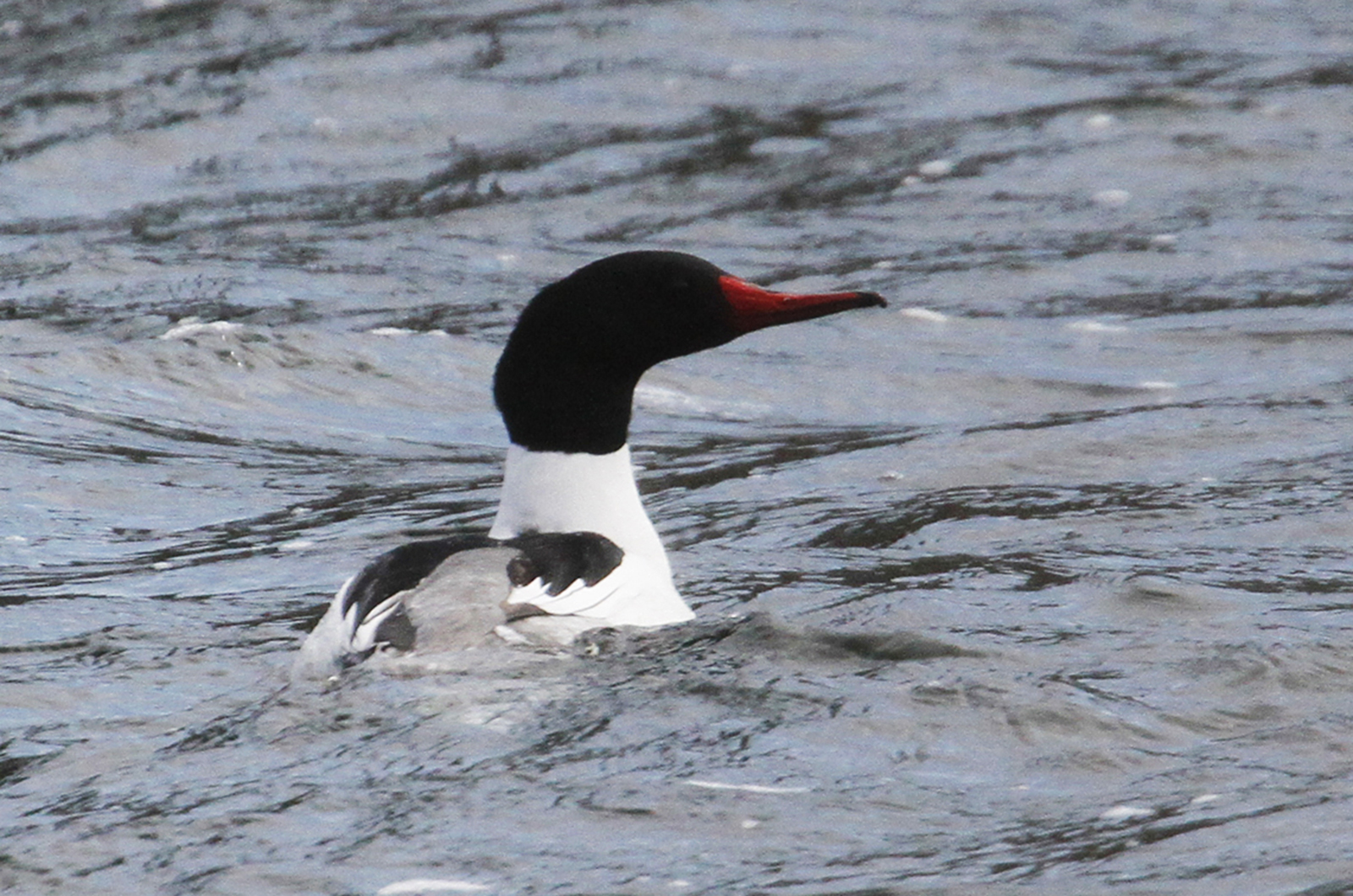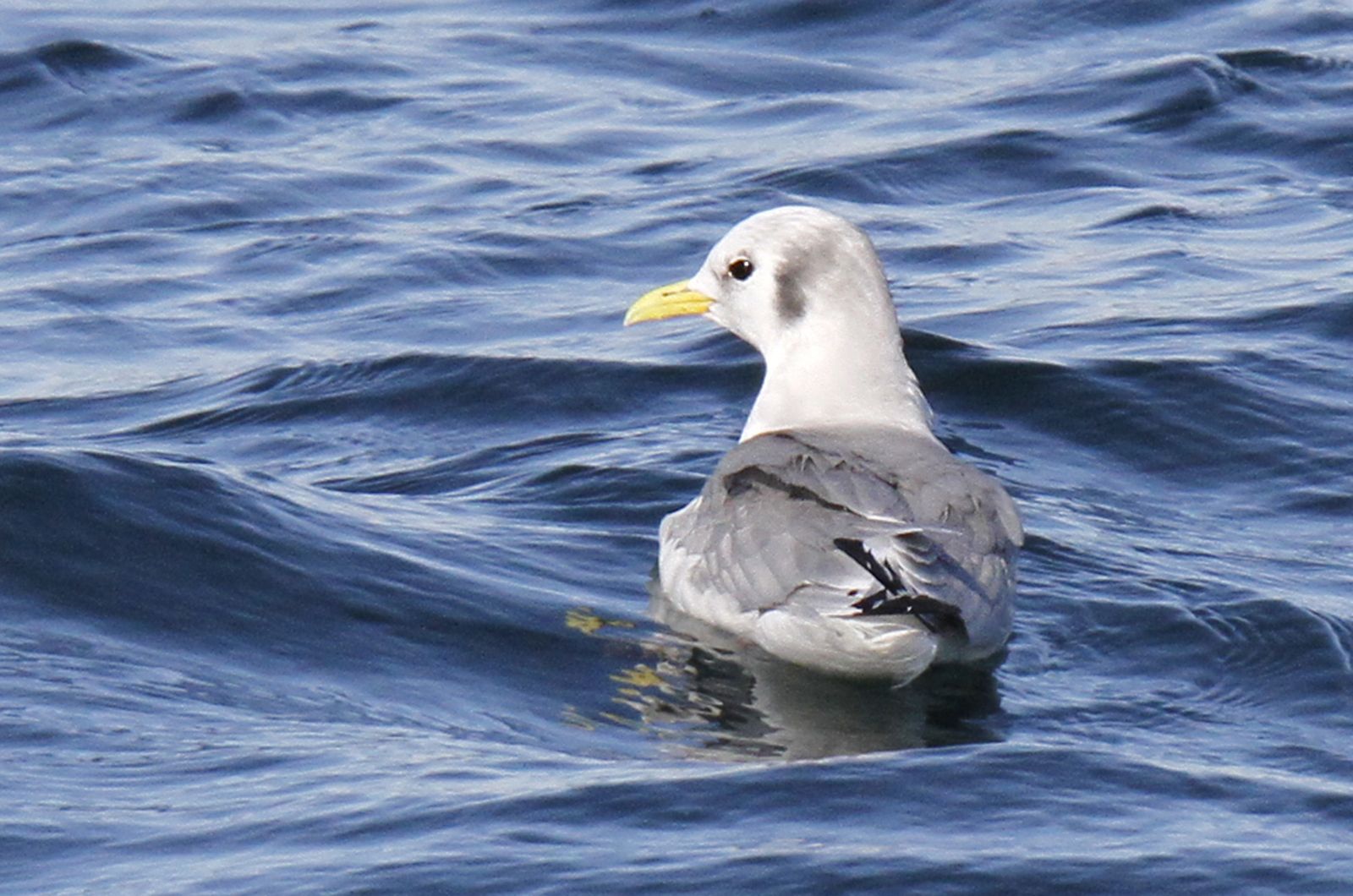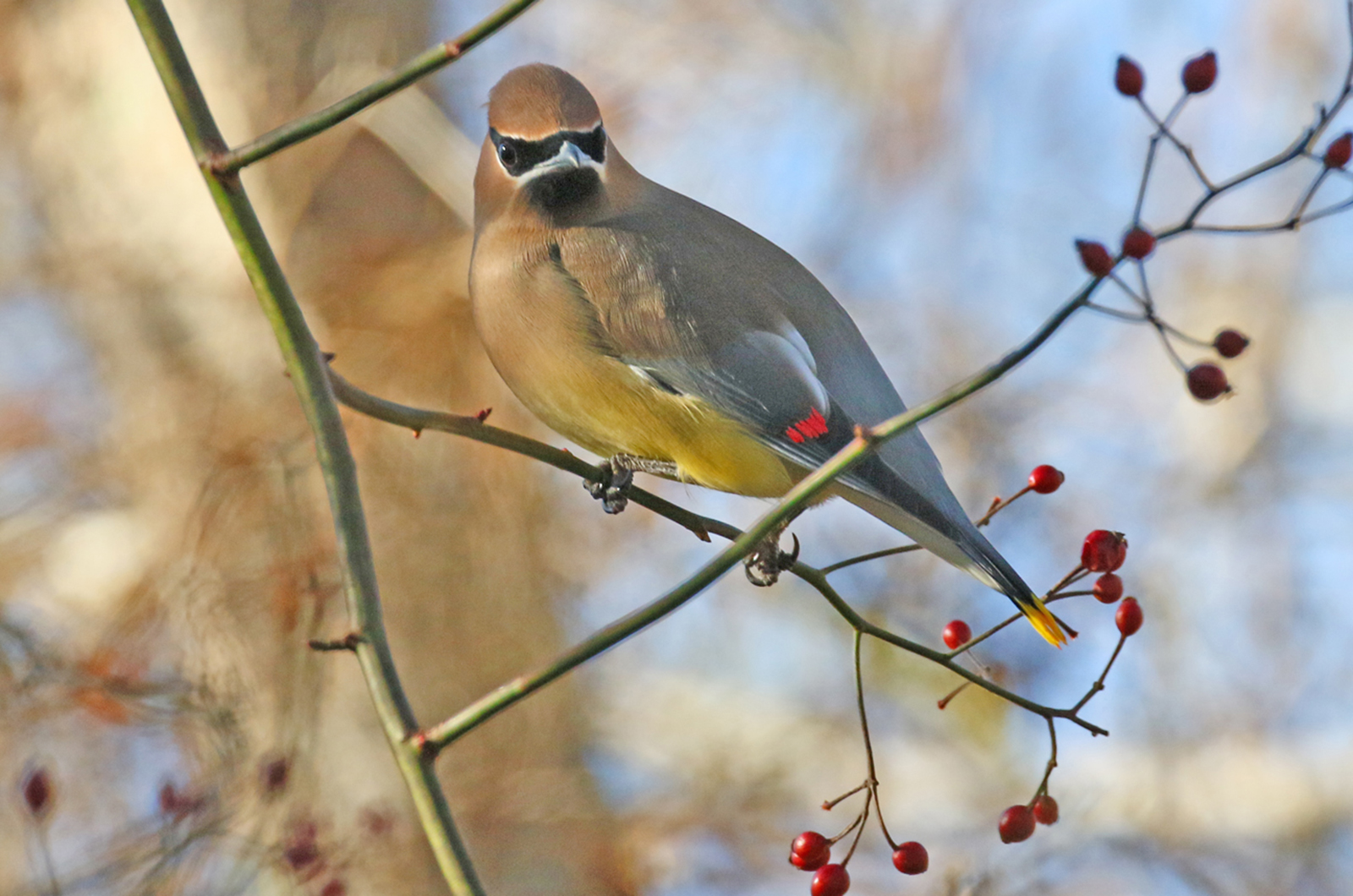Winter resident waterfowl are continuing to arrive as more northern waters freeze over. The population of these ducks will continue to increase for the next four to six weeks.
The first species is the common merganser, seen by Shea Fee on Nov. 23 at Felix Neck. There were two female common mergansers near one female red-breasted merganser, which simplifies noticing the distinctions between the two similar species.
Next is the northern shoveler, a species somewhat resembling a mallard but with a larger bill that sort of resembles a shovel. Occasionally there is rhyme and reason behind a species name. On Nov. 21 both Chris Scott and Joan Smyth spotted three shovelers on Crystal Lake, and on Nov. 24 Susan Whiting saw one of them in the same location.
Then we have the lesser and greater scaup — two species of ducks that closely resemble each other — the shape of the head is one of the best ways to distinguish between these species. Unfortunately, they can adjust the feathers to conceal their head shape. Earlier this month we had only a few sightings of small groups of scaup, but they have become widespread.
Joan Smyth observed 16 greater scaup and 35 lesser scaup at Lucy Vincent Beach on Nov. 20. The next day she found eight lesser scaup at Crystal Lake. The largest number of scaup this week is Matthew Born’s 300 greater scaup in Squibnocket Pond on Nov. 21. Then there were five repots of scaup on Nov. 23. Anne Culbert and I spotted 16 scaup that we could not identify to species. Alex Lin-Moore saw seven lesser scaup at Lucy Vincent Beach. Nancy Nordin, Thaw Malin and Cynthia Bloomquist discovered 20 lesser scaup at Black Point Pond. Luanne Johnson, Margaret Curtin and Nancy Weaver observed two greater scaup at the Oak Bluffs pumping station. And Phil Stanton and Susan Whiting spotted 18 lesser scaup on Tisbury Great Pond. Then on Nov. 25 Matt Pelikan watched two greater scaup at the Oak Bluffs pumping station (also known as Upper Lagoon Pond).
On Nov. 21 Chris Scott visited Philbin Beach and added 12 purple sandpipers — specialists of offshore boulders and rocky beaches — to the fall season list. On Nov. 25 he spotted three black-legged kittiwakes offshore from the Gay Head Cliffs, only the second sighting of the season. More are certain to follow.
Brown thrashers are never abundant on the Island, and there have only been three reports of single individuals of this species this November: Charles Morano at Quansoo Farm on Nov. 12, Susan Whiting and Nancy Nordin at the Oak Bluffs pumping station on Nov. 16, and Nancy Nordin at the Gay Head Cliffs on Nov. 24.
Tree swallows are lingering later and have even stayed into the winter with increasing frequency. This week the reports come from Aquinnah, although not just the Gay Head Cliffs. Chris Scott observed a flock of 150 on Nov. 21 at Philbin Beach, Bob Shriber watched 35 tree swallows and one blue-headed vireo — also lingering — on Nov. 24 in Aquinnah, the same day that Stephanie Mashek saw a flock of 60 at the Gay Head Morraine. The next day Bob Shriber found 42 of them at the Gay Head Cliffs.
The numbers of lingering greater yellowlegs have diminished in the last half of November, with no large flocks and only seven or eight individuals reported. Joan Smyth saw two at Dyke bridge on Nov. 17 and three at Ferryboat Island on Nov. 18. Shea Fee found one at Pocha Pond Reservation on Nov. 17 and one at Felix Neck on Nov. 23. Perhaps that same bird was seen again by Nancy Nordin the next day.
Frugivores — berry eaters — are fairly conspicuous and can be found almost anywhere there are fruiting juniper, crabapple, wild cherry or winterberry (the red berries near wetlands) bushes. Look for mixed flocks of cedar waxwings, eastern bluebirds, American robins, pine warblers and others. You may hear the birds calling back-and-forth before you see them.
On Nov. 21 Thaw Malin and Cynthia Bloomquist saw 10 cedar waxwings at the Polly Hill Arboretum, while Nancy Nordin and Nancy Weaver discovered 18 bluebirds two yellow-bellied sapsuckers, two brown creepers and two pine warblers at Tashmoo Springs.
Sandra Talanian found at least five cedar waxwings on Nov. 23 in Katama. Also that day, Shea Fee spotted 12 cedar waxwing, four bluebirds and two robins at Felix Neck.
Will Harcourt-Smith observed eight cedar waxwings and two robins at Mytoi Japanese Garden on Nov. 24. Anne Culbert and I watched 12 bluebirds, five pine warblers, four chipping sparrows, five cedar waxwings and a barn owl (the latter in the outside nesting box along the road into Felix Neck’s Fall Festival on Nov. 24.
The numbers of loons spotted this week is somewhat remarkable. Usually common loons are more common than red-throated loons. But on Nov. 24 in Aquinnah Bob Shriber saw 22 red-throated and only three common loons. The next day at the Gay Head Cliffs he spotted 15 red-throated and one common loon. At the other end of the Island, at Wasque, Shea Fee found 30 red-throated and one common loon, 30 Bonaparte’s gulls and at least 200-plus razorbills streaming past from the west on Nov. 25.
So far this fall we have not seen the following species: Eurasian wigeon, Barrow’s goldeneye, broad-winged hawk, rough-legged hawk, snowy owl, black-headed gull, Iceland gull, glaucous gulls, western kingbird, fox sparrow, American tree sparrow, Lapland longspur or common redpoll. They are all on my wish list for December!
And here are a few miscellaneous sightings. Chris Scott spotted an immature bald eagle on Nov. 23 at Turkeyland Cove and Nancy Nordin found an almost adult bald eagle on the osprey pole at the Allen Farm on Nov. 26. An American kestrel was seen by Shea Fee at Wasque on Nov. 21 and by Lanny McDowell on Nov. 24 at Katama.
Please email your sightings to birds@vineyardgazette.com.
Robert Culbert is an ecological consultant with Nature Watch LLC living in Vineyard Haven.








Comments
Comment policy »